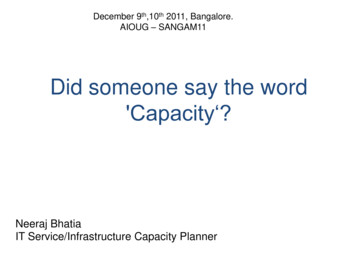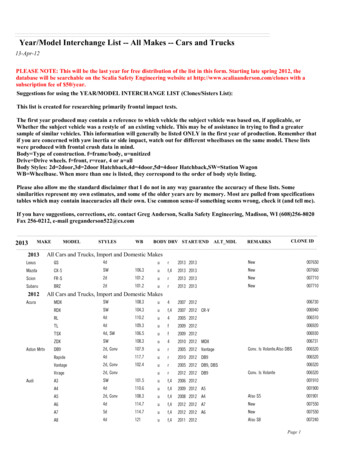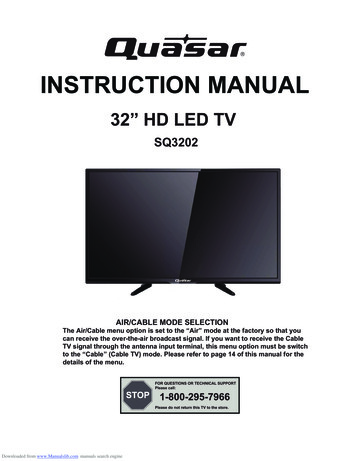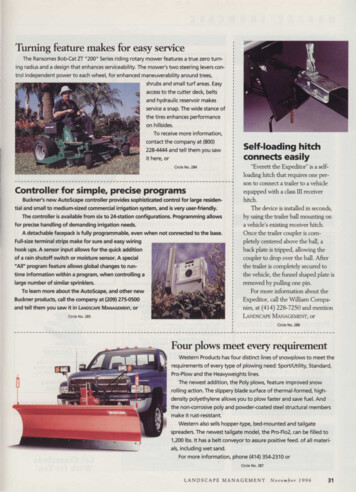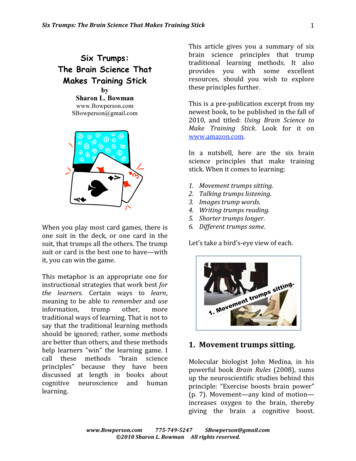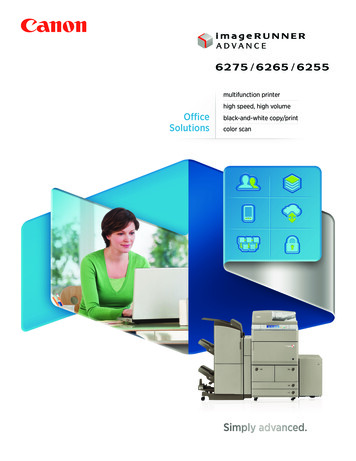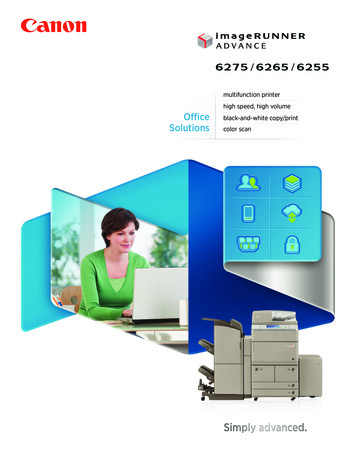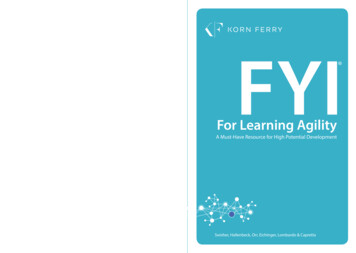
Transcription
FYI For Learning AgilityWhat makes someone a High Potential?FYI For Learning Agility Leaders of today and tomorrow need to be better than the leaders they replacebecause the challenges are greater, the speed faster, the competition tougher,and the marketplace increasingly global. In short, the leaders of today andtomorrow must be agile leaders, resourceful in the face of change, and above all,able to learn from experience. People with this ability perform well underfirst-time, challenging conditions. These people are learning agile.FYI for Learning Agility 2nd Edition is designed to help any motivated persondevelop skills that will lead to increased Learning Agility. The suggestions providedare aimed at gaining insight on learning strengths and remedying skill needs.Powerful content includes:A Fundamentals of Learning Agility chapter that explores the researchfoundation behind the concept of Learning Agility and implications forapplying Learning Agility in both the identification and development oftomorrow’s leaders.Over 250 easy-to-implement Tips to Increase Skills to develop Learning Agility.Listings in each chapter of Assignments to Practice Skill that researchshows provide the richest learning experiences and opportunities to developLearning Agility.A list of Resources to Learn More in each chapter—books, articles, blogs,video links—to help deepen understanding and include in Learning Agilitydevelopment plans.A Development Plan with an easy-to-use form to record Learning Agilitydevelopment needs and action plan.For Learning AgilityA Must-Have Resource for High Potential Development2ND EDITIONBased on the groundbreaking research that has identified what behaviors leadto executive success, this book provides all the resources needed to understandLearning Agility and to devise a plan to increase Learning Agility.For additional information and related publications,please contact korn/ferry leadership and talentconsulting at business office@kornferry.com orvisit us at www.kornferry.com/productsFYI ISBN 978-1-933578-49-1Item number: 82199 Korn Ferry 2013-2015. All rights reserved.9 781933578491 Swisher, Hallenbeck, Orr, Eichinger, Lombardo & Capretta
FYI For Learning Agility2nd edition Korn Ferry 2004–2015. All rights reserved.No part of this work may be copied or transferred to any otherexpression or form without a license from Korn Ferry.For the sake of linguistic simplicity in this product, only the masculineform is used. However, in each case, the feminine form should always beunderstood to be included.Leadership Architect , Choices , Learning Agility Architect andFYI for Learning Agility are the exclusive trademarks of Korn Ferry.www.kornferry.comISBN 978-1-933578-49-1 PrintISBN 978-1-933578-49-1-58-3 PDFItem number 82199Printings:FYI for Learning Agilityversion 10.1a–01/10FYI for Learning Agility 2nd editionversion 13.1a–04/13version 13.1a–10/14version 13.1a–10/15
Table of ContentsIntroduction. 1About the Authors. 6Fundamentals of Learning Agility. 8Multi-Rater Assessment of Learning Agility. 17References. 25FACTOR I: SELF AWARENESS.31Personal Learner. 32Feedback Oriented. 40Reflective. 48Emotion Management. 54Self-Knowledge. 60FACTOR II: MENTAL AGILITY.67Inquisitive. 68Broad Scanner. 76Connector. 84Essence. 92Complexity. 100Manages Uncertainty. 108FACTOR III: PEOPLE AGILITY.117Open Minded. 118People Smart. 126Situational Flexibility . 134Agile Communicator. 142Conflict Manager. 150Helps Others Succeed. 158FACTOR IV: CHANGE AGILITY.167Continuous Improver. 168Visioning. 176Experimenter. 184Innovation Manager. 192Comfort Leading Change. 200 Korn Ferry 2004–2015. All rights reserved.
FACTOR V: RESULTS AGILITY.209Drive. 210Resourcefulness. 216Presence. 224Inspires Others. 232Delivers Against the Odds. 240Acknowledgments.249Development Plan.251Appendix.257Resources to Learn More – Web Addresses. 257Notes.265Additional Resources.269 Korn Ferry 2004–2015. All rights reserved.
IntroductionA fundamental shift has taken place in the world of work. Permanent forces ofchange are taking hold in the form of globalization, technological shifts, andeconomic and political uncertainty. Everything’s faster, more interconnected,complex, and ambiguous than ever before. As a result, the era of job stabilityand predictability is now a thing of the past.The only way to survive, let alone thrive, in the face of such overwhelmingchange is to adapt at the same pace of the change, if not even faster. Thismeans being able to develop new skills in the blink of an eye, to face unfamiliarchallenges without a “playbook” to guide you, to find an answer when theproblem itself isn’t clear. In short, it means you have to become adept atknowing what to do when you don’t know what to do.But how do you do that? The secret is something called Learning Agility.Individuals who excel at Learning Agility have mastered the ability to effectivelylearn from their experiences. They embrace what happens to them, both goodand bad, and look for the key takeaways and lessons learned. And they don’tstop there. They seek ways to actively apply those lessons, especially to newand difficult challenges that they face.Learning Agility is a well-defined set of behaviors that has been studied forseveral decades. While skill at Learning Agility does vary, it is an ability that canbe developed, primarily through seeking and gaining from experiences thatbuild breadth and adaptability. This book breaks down the specific elements ofLearning Agility and provides a practical, actionable approach to developingwhat has now become one of the must-have skills for workplace success.WHO IS THIS BOOK FOR?This book was designed for any motivated person seeking to develop skillsthat lead to increased Learning Agility. The suggestions provided are aimed atgaining insight and strength in specific areas where Learning Agility needs tobe developed. It does not matter what level of the organization you are a partof or what type of industry or function you are in. If you perceive that LearningAgility is important to your current and future success and you are committedto developing, this book is for you. In addition to individual learners, the contentwill also help anyone who is serving as a manager, mentor, or feedback giver.1 Korn Ferry 2004–2015. All rights reserved.
INTRODUC TIONTiming is important. Do make certain that you are ready to develop.The earliest and most critical stages in the development process are theawareness and acceptance of the need to develop. If you are in denial,rationalizing, confused, or being defensive about having needs, this bookwill not help.Awareness and acceptance aren’t enough though. You also need to bemotivated. Individuals who accept that they have a need to increase theirLearning Agility but do not have the motivation, drive, urgency, or energy todo anything about it will also not be helped by what’s in this book.So, this book is intended for people who believe they have a need and want todo something about it. If this describes you, there are hundreds of tips in thisbook that will help you develop skills that lead to increased Learning Agility.THE STRUCTURE OF THIS BOOK:Each of the 27 chapters addresses one of the dimensions of Learning Agilityand includes the following sections:1. Map – At the beginning of each dimension chapter, the map explains keyelements of the dimension and their importance.2. Quotations – Quotations are provided at the beginning and end of eachdimension chapter for the purpose of inspiration and reflection.3. Definition – What Skilled, Less Skilled, and Overuse look like for thisdimension of Learning Agility.4. Some Possible Causes of Lower Skill – We list numerous reasons whyyou might have this need. Use these to specify what your need looks likeexactly.5. Developmental Difficulty – Each dimension is classified as EasierModerateor Harderto develop. This will help you set yourexpectations regarding the scope and speed of your development.or6. Did You Know / Does It BestEach dimension is highlighted withresearch-related insights or a brief portrait of someone who serves as aprime example of skilled behavior.2 Korn Ferry 2004–2015. All rights reserved.
Look for this symbol for tips on how to avoid overusing your skill in eachdimension.8. Assignments to Practice Skill – Ideas for ways to pursue developmentalopportunities in the dimension both on and off the job.9. Take Time to Reflect – Each chapter closes with a series of thoughtprovoking questions to inspire further reflection on the dimension andraise your level of self-awareness.HOW DO I USE THIS BOOK?There are several practices and approaches we find useful for getting the mostout of this book:Determine the need. From regular feedback or use of the Learning AgilityArchitect Sort Cards, Quick Score Questionnaire, or Choices onlineassessment, try to determine your current level of Learning Agility andwhich areas you could benefit from working on. Sometimes even excellentfeedback can identify the wrong need. Even if everyone agrees that youhave problems managing conflict, the question is “Why?” Maybe the realproblem is due to your not being open to others’ opinions or not beingable to read people’s reactions. So if none or only a few of the tips for youridentified need seem to make sense, check other likely dimensions to see ifthe need is more likely one of those.Get the lay of the land. Read the map for the dimension at the start ofeach chapter. The map describes the general case of the behavior, how itoperates, and why it’s important. The map sets context and helps clarifywhat the dimension is all about.Specify the need. Read the Less Skilled definition for the dimension.Which bullet points describe your particular situation best? Look to theSkilled definition. How do you want to act when you have developed in thisdimension? This is the before and after picture. Also consider the potentialfor Overuse.3 Korn Ferry 2004–2015. All rights reserved.INTRODUC TION7. Tips to Increase Skill – Research- and experience-based suggestions foractions that you can take to increase effectiveness in each dimension.Choose a few to include in your development plan. Also consult theResources to Learn More for more tips and deeper understanding.
INTRODUC TIONAsk “Why?” Check the Possible Causes that might apply. Manydevelopmental efforts have floundered because the plan attacked thewrong problem. Causes get to “why” you may have a need in this dimension.Write down your specific need—what it looks like, what causes it, who itplays out with, and in what situations.Conduct a reality check. Take note of the Developmental Difficulty level ofthe dimension. Some weaknesses are tougher to fix than others. Knowingthe relative difficulty of working on a need will help set you up for success.Identify the fixes. Look at the Tips to Increase Skill and pick the specific onesthat apply. Each topic is written against a specific manifestation of beingless skilled at the dimension. It is unlikely that all of the topics or remedieswill apply to any person. Pick a few that apply. Start small. Think back to thecauses you checked and the “why it’s important” noted from the map.Seek out more knowledge. Look at the list of recommended Resourcesto Learn More. They might also be helpful to deepen your understandingon your needs and to help put together the action plan. Complete Webaddresses appear in the Resources to Learn More – Web Addresses appendix.Get ready. Get set Lay out a plan and a schedule. The plan should includeat least three items you will work on immediately. Use the developmentplan in the back of this book. Measure the number of times you do this ordon’t do that and record these efforts so you can track improvement. Set aspecific time frame of no more than a month to try these items repeatedly.If the time frame is longer or indefinite, you will be less likely to do anything.Start today.Begin the journey. Make it a journey of challenge. It’s simply the mosteffective way to learn. In particular, put these practices to work for maximumlearning gain:Go against your natural grain. We call these GAG (Going Against yournatural Grain). GAG because, while it’s great for your development, it’suncomfortable. If you’re ambitious or if you seek a different kind of job,you’ll have to work on your downsides more vigorously. Few succeed in adifferent job by simply repeating past successful behavior. This is a stronglesson from career research. You’ll have to stretch in uncomfortable areas.For example, whether you gravitate toward team building or not, youcan learn the behaviors of excellent team builders. You might even cometo enjoy it. It’s important not to confuse what you like to do with what’snecessary to do.4 Korn Ferry 2004–2015. All rights reserved.
Seek further feedback. Little happens without feedback tied to agoal. Get a developmental partner, get feedback a year from now onthe Choices online assessment, ask for a Learning From Experience interview, poll people you work with about what you should keep doing,keep doing with slight modifications, stop doing, and start doing.Finally, remember that Learning Agility is forged by experience. Experiences areneeded to provide the seeds for learning and even more experiences are neededto provide opportunities to apply and refine those learnings. So be patient andstay committed to continually embracing, reflecting on, and applying whatevercan be gleaned from the many experiences that await you.5 Korn Ferry 2004–2015. All rights reserved.INTRODUC TIONTest the unknown. Many
FYI for Learning Agility 2nd Edition is designed to help any motivated person develop skills that will lead to increased Learning Agility. The suggestions provided are aimed at gaining insight on learning strengths and remedying skill needs. Powerful content includes: A Fundamentals of Learning Agility chapter that explores the research foundation behind the concept of Learning Agility and .
